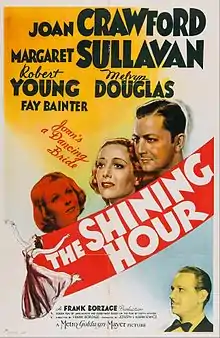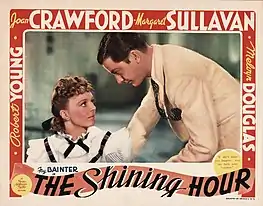| The Shining Hour | |
|---|---|
 Original Film Poster | |
| Directed by | Frank Borzage |
| Screenplay by | Jane Murfin Ogden Nash |
| Based on | The Shining Hour 1934 play by Keith Winter |
| Produced by | Joseph L. Mankiewicz Frank Borzage (uncredited) |
| Starring | Joan Crawford Margaret Sullavan Robert Young Melvyn Douglas |
| Cinematography | George J. Folsey |
| Edited by | Frank E. Hull |
| Music by | Franz Waxman |
Production company | |
| Distributed by | Loew's Inc |
Release date |
|
Running time | 76 minutes |
| Country | United States |
| Language | English |
| Budget | $1,068,000[1] |
| Box office | $1,367,000[1] |

The Shining Hour is a 1938 American romantic drama film directed by Frank Borzage, based on the 1934 play The Shining Hour by Keith Winter, and starring Joan Crawford and Margaret Sullavan. The supporting cast of the MGM film features Robert Young, Melvyn Douglas, Fay Bainter and Hattie McDaniel.
Plot
Olivia Riley (Joan Crawford), a New York City nightclub dancer, tires of the fast life and consents to marry Henry Linden (Melvyn Douglas), a wealthy farmer from Wisconsin. Even before they engage to be married, however, Henry's brother David (Robert Young) is sent to New York by their domineering sister Hannah (Fay Bainter) to dissuade him from marrying Olivia. In private, Olivia slaps David when her integrity is questioned, but she marries Henry because she says he's the only person in her life who is endlessly positive. When Olivia moves to her new husband's farm in Wisconsin, she encounters trouble from her sister-in-law Hannah, who does not approve of her. Olivia finds an ally in David's wife, Judy (Margaret Sullavan), who is in a loveless marriage.
Olivia comes to realize that she and Judy are in the same situation. Olivia's situation is further complicated when David defends her from the unwanted advances of a farm hand and he begins to fall in love with her. Henry is unaware of this, but Hannah finds out what is going on, and in a drunken rage she sets fire to the house that's being built for Henry and Olivia. Olivia saves a badly burned Judy, and David realizes he has loved Judy after all. Olivia then decides to leave the farm; and, as she drives away, Henry joins her and they leave together.
Production
After Crawford and Franchot Tone had seen the original play, she asked MGM head, Louis B Mayer, to considered making a film adaptation. Though they had planned for Norma Shearer to star in a 1936 version, it ultimately did not come to fruition.[2][3]
Crawford later asked for both Fay Bainter and Margaret Sullavan to star alongside her in the film. Production began on August 22nd, finishing on October 3rd, 1938.[4] Melvyn Douglas later noted Crawford and Sullavan got on well together on set.[5] Gowns and set designs for the film were by Adrian and Cedric Gibbons.[6]
Cast
- Joan Crawford as Olivia Riley
- Margaret Sullavan as Judy Linden
- Robert Young as David Linden
- Melvyn Douglas as Henry Linden
- Fay Bainter as Hannah Linden
- Allyn Joslyn as Roger Q. Franklin
- Hattie McDaniel as Belvedere
- Oscar O'Shea as Charlie Collins
- Frank Albertson as Benny Collins
- Harry Barris as Bertie
- Tony de Marco as uncredited dancer[7]
Reception and box office
According to MGM records, the film earned $942,000 in the U.S. and Canada and $425,000 in other markets, realizing for the studio a total box office of $1,367,000. Those receipts, less the production's cited budget of $1,068,000, resulted in a profit of $299,000 for MGM.[1]
The film received lukewarm reviews by critics. Variety said of the film:
Joan Crawford, as the showgirl, carries most of the footage. Fay Bainter, as the resentful sister-in-law, is handicapped by script and dialog. Margaret Sullavan shows to advantage in a few instances, while Melvyn Douglas is rather smug and conservative as the husband. More zing in the romancing of Robert Young with Crawford would have generated some interest in rather dull passages.[8]
Though, Margarita Landazuri of Turner Classic Movies said in 2004:
All three women turned in excellent performances in The Shining Hour, with Crawford rising to the challenge presented by her co-stars. And all three responded to the sensitive direction of Frank Borzage, whose best films revolved around emotional, spiritual, and idealistic themes.turned in excellent performances in The Shining Hour, with Crawford rising to the challenge presented by her co-stars. And all three responded to the sensitive direction of Frank Borzage, whose best films revolved around emotional, spiritual, and idealistic themes.[4]
References
- 1 2 3 The Eddie Mannix Ledger, Los Angeles: Margaret Herrick Library, Center for Motion Picture Study.
- ↑ "CONTENTdm". digitalcollections.oscars.org. Retrieved 2024-01-08.
- ↑ Chandler, Charlotte (2012-12-11). Not the Girl Next Door: Joan Crawford: A Personal Biography. Simon and Schuster. ISBN 978-1-4711-0586-9.
- 1 2 "The Shining Hour". www.tcm.com. Retrieved 2024-01-08.
- ↑ Bawden, James; Miller, Ron (April 2016). Conversations with Classic Film Stars: Interviews from Hollywood’s Golden Era. University Press of Kentucky. ISBN 978-0-8131-6712-1.
- ↑ "THE SCREEN; 'The Great Man Votes' Comes to the Music Hall-- 'The Shining Hour at Capitol--New Film at Palace". The New York Times. 1939-01-20. ISSN 0362-4331. Retrieved 2024-01-08.
- ↑ Cullen, Frank; Hackman, Florence; McNeilly, Donald (2007). Vaudeville old & new: an encyclopedia of variety performances in America. Psychology Press. ISBN 978-0-415-93853-2.
- ↑ Staff, Variety (1938-01-01). "The Shining Hour". Variety. Retrieved 2024-01-08.
External links
- The Shining Hour at IMDb
- The Shining Hour at AllMovie
- The Shining Hour at the TCM Movie Database
- The Shining Hour at the American Film Institute Catalog